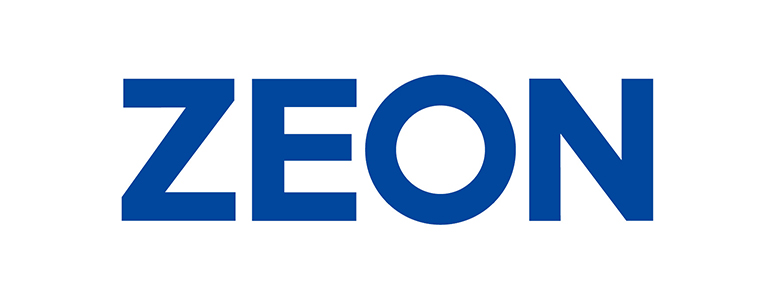| ZEON CORPORATION (4205) |
|
||||||||
Company |
ZEON CORPORATION |
||
Code No. |
4205 |
||
Exchange |
TSE 1st Section |
||
Industry |
Chemicals |
||
President |
Kimiaki Tanaka |
||
HQ Address |
Marunouchi 1-6-2, Chiyoda-ku, Tokyo |
||
Year-end |
March |
||
URL |
|||
* Share price as of closing on July 11, 2018. Number of shares outstanding as of the last year-end and does not include treasury shares. ROE and BPS are from the last year-end.
|
||||||||||||||||||||||||
|
|
* Estimates are those of the Company. Net income is net income attributed to parent shareholders.
|
| Key Points |
 |
| Company Overview |
|
ZEON CORPORATION is a petrochemical manufacturer that maintains numerous products with a large share of the global markets including synthetic rubber used in automobile parts and tires, synthetic latex used in surgery-use gloves, and other products. The Company's strengths include its creative technology development function, R&D structure, and high earnings generation capability. Many of the products and materials manufactured by Zeon are used in a wide variety of products including automobile parts and tires, rubber gloves, disposable diapers, cell phones, LCD televisions, perfumes and other products commonly used in everyday life. The Zeon Group is comprised of the parent company, 58 subsidiaries and 9 affiliated companies. Zeon also has manufacturing and marketing facilities in 16 countries around the world.
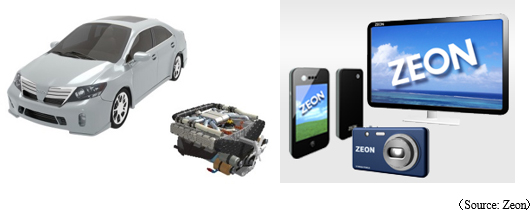 (Company Name and Management Vision)
The company name "Zeon" is derived from the Greek word for earth "geo" (phonetically pronounced "zeo" in Japanese) and the English word reflecting eternity "eon," and reflects the Company's principle of "deriving raw materials from the earth and perpetually contributing to human prosperity" through the development and application of creative technologies. (Zeon's original name "Geon," used at the time of its establishment, was derived from the trademark acquired for the vinyl chloride resin "Geon" from the Goodrich Corporation (then called B.F. Goodrich Company) in the United States, with which it had capital and collaborative technological agreements. The company name was changed to "Zeon" when the capital agreement was dissolved in 1970.)
(Corporate History)
Zeon was established as a joint venture company formed by the Furukawa Group of companies: Nippon Light Metal Co., Ltd., Furukawa Electric Co., Ltd., and Yokohama Rubber Co., Ltd. in April 1950 to acquire and use the vinyl chloride resin technology from B.F. Goodrich Chemicals Co.
In 1951, Goodrich acquired 35% of the shares of Zeon for full-scale technological and capital partnership, and in 1952 mass production of vinyl chloride resin began in Japan for the first time.
In 1959, Goodrich transferred synthetic rubber manufacturing technologies to Zeon, which, in turn, started Japan's first mass production of synthetic rubber. Manufacturing facilities were also expanded to match the growing demand for tires and other automobile parts.
In 1965, use of the Company's unique technology called Geon Process of Butadiene (GPB) for the efficient manufacture of butadiene (main raw material of synthetic rubber) from C4 fraction was operational.
Goodrich transferred its specialty synthetic rubber business to Zeon along with the shift in its main business focus toward vinyl chloride resins. Capital ties were dissolved in 1970. Along with these changes, the Company name was changed from Geon to Zeon in 1971.
Also in 1971, Zeon developed a unique technology called Geon Process of Isoprene (GPI) and began using it to manufacture raw materials including high-purity isoprene, hydrocarbon resins, and synthetic perfume ingredients from C5 fraction.
After entering the 1980s, Zeon aggressively launched new businesses in various fields including photoresists and other information materials, and medical-related applications in addition to its main synthetic rubber business.
In 1984, production of hydrogenated nitrile rubber Zetpol®, which currently has top share of the worldwide market, began at the Takaoka Plant.
In 1990, manufacture of synthetic cyclo-olefin polymer resin (COP) ZEONEX®, which is the main product of the specialty material business using the GPI method to extract and synthesize products, was started at the Mizushima Plant.
In 1993, Zeon entered China with its electronics materials business.
In 1999, Zeon Chemicals L.P. (Consolidated subsidiary in the United States) acquired the specialty rubber business of Goodyear Tire & Rubber Company of the United States to become the world's top manufacturer of specialty rubber.
In 2000, Zeon discontinued production of vinyl chloride resins at the Mizushima Plant, and thus withdrew from the Company's founding business.
Since the 21st century came, the company has been operating business actively, for example, by releasing ZeonorFilm®, an optical film for LCD, strengthening global production and sales systems, starting the commercial operation of styrene-butadiene rubber (S-SBR) in Singapore, upgrading the equipment for optical films for LCD in Himi-shi, Toyama Prefecture, starting the operation of the world's first mass-production factory for super-growth carbon nanotubes, and establishing a joint venture for manufacturing and selling S-SBR in cooperation with Sumitomo Chemical in Singapore.
(Business Description)
Zeon's main products use various extracted from naphtha, which is extracted by distillation of crude oil.
Zeon uses butadiene extracted in the GPB method developed in-house from C4 fraction after extracting propylene (C3), isoprene monomer (IPM) extracted from C5 fraction using the GPI method, high-boil monomer (HB), dicyclopentadiene (DCPD), and 2-butyne as raw materials to be processed into synthetic rubber, synthetic latex and various other materials. (Company Name and Management Vision)
The company name "Zeon" is derived from the Greek word for earth "geo" (phonetically pronounced "zeo" in Japanese) and the English word reflecting eternity "eon," and reflects the Company's principle of "deriving raw materials from the earth and perpetually contributing to human prosperity" through the development and application of creative technologies. (Zeon's original name "Geon," used at the time of its establishment, was derived from the trademark acquired for the vinyl chloride resin "Geon" from the Goodrich Corporation (then called B.F. Goodrich Company) in the United States, with which it had capital and collaborative technological agreements. The company name was changed to "Zeon" when the capital agreement was dissolved in 1970.)
(Corporate History)
Zeon was established as a joint venture company formed by the Furukawa Group of companies: Nippon Light Metal Co., Ltd., Furukawa Electric Co., Ltd., and Yokohama Rubber Co., Ltd. in April 1950 to acquire and use the vinyl chloride resin technology from B.F. Goodrich Chemicals Co.
In 1951, Goodrich acquired 35% of the shares of Zeon for full-scale technological and capital partnership, and in 1952 mass production of vinyl chloride resin began in Japan for the first time.
In 1959, Goodrich transferred synthetic rubber manufacturing technologies to Zeon, which, in turn, started Japan's first mass production of synthetic rubber. Manufacturing facilities were also expanded to match the growing demand for tires and other automobile parts.
In 1965, use of the Company's unique technology called Geon Process of Butadiene (GPB) for the efficient manufacture of butadiene (main raw material of synthetic rubber) from C4 fraction was operational.
Goodrich transferred its specialty synthetic rubber business to Zeon along with the shift in its main business focus toward vinyl chloride resins. Capital ties were dissolved in 1970. Along with these changes, the Company name was changed from Geon to Zeon in 1971.
Also in 1971, Zeon developed a unique technology called Geon Process of Isoprene (GPI) and began using it to manufacture raw materials including high-purity isoprene, hydrocarbon resins, and synthetic perfume ingredients from C5 fraction.
After entering the 1980s, Zeon aggressively launched new businesses in various fields including photoresists and other information materials, and medical-related applications in addition to its main synthetic rubber business.
In 1984, production of hydrogenated nitrile rubber Zetpol®, which currently has top share of the worldwide market, began at the Takaoka Plant.
In 1990, manufacture of synthetic cyclo-olefin polymer resin (COP) ZEONEX®, which is the main product of the specialty material business using the GPI method to extract and synthesize products, was started at the Mizushima Plant.
In 1993, Zeon entered China with its electronics materials business.
In 1999, Zeon Chemicals L.P. (Consolidated subsidiary in the United States) acquired the specialty rubber business of Goodyear Tire & Rubber Company of the United States to become the world's top manufacturer of specialty rubber.
In 2000, Zeon discontinued production of vinyl chloride resins at the Mizushima Plant, and thus withdrew from the Company's founding business.
Since the 21st century came, the company has been operating business actively, for example, by releasing ZeonorFilm®, an optical film for LCD, strengthening global production and sales systems, starting the commercial operation of styrene-butadiene rubber (S-SBR) in Singapore, upgrading the equipment for optical films for LCD in Himi-shi, Toyama Prefecture, starting the operation of the world's first mass-production factory for super-growth carbon nanotubes, and establishing a joint venture for manufacturing and selling S-SBR in cooperation with Sumitomo Chemical in Singapore.
(Business Description)
Zeon's main products use various extracted from naphtha, which is extracted by distillation of crude oil.
Zeon uses butadiene extracted in the GPB method developed in-house from C4 fraction after extracting propylene (C3), isoprene monomer (IPM) extracted from C5 fraction using the GPI method, high-boil monomer (HB), dicyclopentadiene (DCPD), and 2-butyne as raw materials to be processed into synthetic rubber, synthetic latex and various other materials.
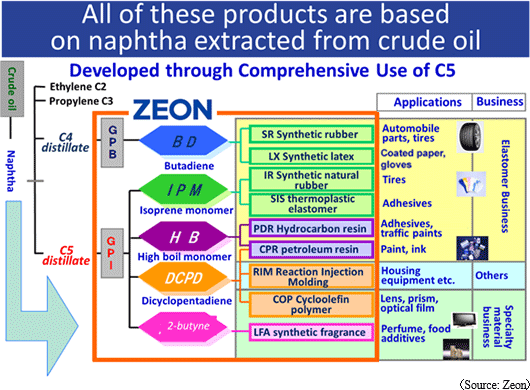 Zeon has three business segments: 1) the elastomer business, where manufactured basic materials are sold to customers; 2) the specialty material business, where basic materials are submitted to primary processing for sale to customers as processed materials, and 3) the other business.
Zeon has three business segments: 1) the elastomer business, where manufactured basic materials are sold to customers; 2) the specialty material business, where basic materials are submitted to primary processing for sale to customers as processed materials, and 3) the other business.
 <Elastomer Business>
Elastomers are "high molecular compounds that have rubber-like elastic properties," an example of which is synthetic rubber. As described in the corporate history section of this report, in 1959 Zeon became the first company in Japan to mass-produce synthetic rubber, which became the foundation underlying all of Zeon's businesses. This business includes the segments of synthetic rubber, synthetic latex, and chemical products (hydrocarbon resins, thermoplastic resins) businesses.
① Synthetic Rubber Business
<Example of final product: Tires>
Zeon provides the world's leading tire manufacturers with the world's highest-quality synthetic rubber for use in tires. Among the various types of synthetic rubber manufactured are styrene butadiene rubber (SBR), which promotes superior abrasion resistance, aging resistance and mechanical strength properties, butadiene rubber (BR), which includes a superior balance between elasticity, wear and low-temperature properties, and isoprene rubber (IR), which features similar high levels of quality, consistency and other properties as natural rubber.
Zeon expects the demand for S-SBR for low fuel consumption tires, which further improved the characteristics of SBR, to expand rapidly in the future. In order to increase the supply capacity corresponding to this, Singapore plant started operation in September 2013 (the first line). The second line started operation in April 2016. The supply capacity of the Singapore plant is 70,000 tons.
<Example of product: Automobile Parts> <Elastomer Business>
Elastomers are "high molecular compounds that have rubber-like elastic properties," an example of which is synthetic rubber. As described in the corporate history section of this report, in 1959 Zeon became the first company in Japan to mass-produce synthetic rubber, which became the foundation underlying all of Zeon's businesses. This business includes the segments of synthetic rubber, synthetic latex, and chemical products (hydrocarbon resins, thermoplastic resins) businesses.
① Synthetic Rubber Business
<Example of final product: Tires>
Zeon provides the world's leading tire manufacturers with the world's highest-quality synthetic rubber for use in tires. Among the various types of synthetic rubber manufactured are styrene butadiene rubber (SBR), which promotes superior abrasion resistance, aging resistance and mechanical strength properties, butadiene rubber (BR), which includes a superior balance between elasticity, wear and low-temperature properties, and isoprene rubber (IR), which features similar high levels of quality, consistency and other properties as natural rubber.
Zeon expects the demand for S-SBR for low fuel consumption tires, which further improved the characteristics of SBR, to expand rapidly in the future. In order to increase the supply capacity corresponding to this, Singapore plant started operation in September 2013 (the first line). The second line started operation in April 2016. The supply capacity of the Singapore plant is 70,000 tons.
<Example of product: Automobile Parts>
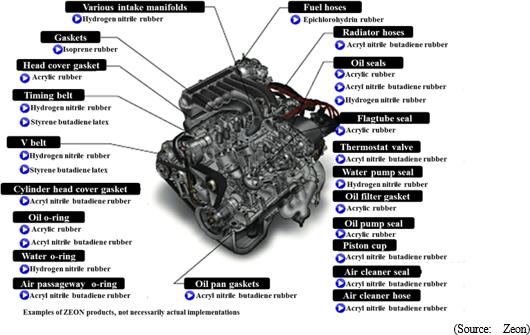 Radiator hoses, fuel hoses, fan belts, oil seals, and various other car engine parts use specialty synthetic rubber that has superior oil resistance and heat deterioration-resistant qualities. Zeon is the world's number one manufacturer of specialty synthetic rubber and features high quality levels and high market share of specialty synthetic rubber automobile parts. In particular, Zeon's Zetpol® hydrogenated nitrile rubber timing belts display superior heat and oil resistance and claims approximately 70% share of the worldwide fan belts market.
Furthermore, a new grade of Zetpol® has vastly improved the performance of products using the original versions of Zetpol®.
Products using the new grade of Zetpol® are heat resistant at temperatures that exceed the limits for the original version of Zetpol® by 15 degrees centigrade, thereby extending the life of seals and gaskets, and are in strong demand for use in next generation bio-fuel engines. The new grade of Zetpol® is well suited to extrusion processing which is being leveraged to expand its usage in various hoses. Products using Zetpol® have also been well received by customers, and are being used increasingly as a replacement material for more expensive competitive rubber in Japan, Asia, Europe and North America.
Commercial production of the new Zetpol® started in November 2012 at Zeon's Kawasaki Plant and reached full-scale production in 2013.
② Synthetic Latex Business
Synthetic latex is liquid rubber that synthetic rubber dispersed in water. It is used to manufacture gloves, paper coating, textile processing, adhesives, paints, and cosmetic puffs, etc. Zeon has close to 90% share of NBR latex used in cosmetic puffs.
③ Chemical Products Business
Zeon produces C5 fraction by its unique in-house GPI method, and turn it into materials for adhesive tapes and hot melt adhesive traffic paint binder and a wide variety of other products.
<Specialty Material Business>
① Specialty Plastics and Electronic Materials
Zeon deals in high value added materials and parts that are created using its unique technologies including polymer design and processing technologies.
Cyclo-olefin polymer is thermoplastic polymer developed using raw material extracted from C5 distillate using GPI methods and synthesized with Zeon's own unique technologies. The commercial products are ZEONEX® and ZEONOR®.
ZEONEX® leverages its high transparency, low water absorption and low absorptive properties for use in camera and projector lenses and other optical applications, and in medical use containers including syringes and vials.
ZEONOR® leverages its high transparency, transferability, and heat resistance properties for use as transparent general use engineering plastics used in light guide plates, automobile parts, containers, discs and a wide range of other product applications.
ZeonorFilm® is the world's first optical film by the melt extrusion method from the cyclo-olefin polymer. It is excellent in optical properties, low water absorption / low moisture permeability, high heat resistance, low outgassing and dimensional stability. Not only for displays for LCD TV, smartphones and tablets, is it expected to be used in a wide range of applications such as digital signage in the future.
Radiator hoses, fuel hoses, fan belts, oil seals, and various other car engine parts use specialty synthetic rubber that has superior oil resistance and heat deterioration-resistant qualities. Zeon is the world's number one manufacturer of specialty synthetic rubber and features high quality levels and high market share of specialty synthetic rubber automobile parts. In particular, Zeon's Zetpol® hydrogenated nitrile rubber timing belts display superior heat and oil resistance and claims approximately 70% share of the worldwide fan belts market.
Furthermore, a new grade of Zetpol® has vastly improved the performance of products using the original versions of Zetpol®.
Products using the new grade of Zetpol® are heat resistant at temperatures that exceed the limits for the original version of Zetpol® by 15 degrees centigrade, thereby extending the life of seals and gaskets, and are in strong demand for use in next generation bio-fuel engines. The new grade of Zetpol® is well suited to extrusion processing which is being leveraged to expand its usage in various hoses. Products using Zetpol® have also been well received by customers, and are being used increasingly as a replacement material for more expensive competitive rubber in Japan, Asia, Europe and North America.
Commercial production of the new Zetpol® started in November 2012 at Zeon's Kawasaki Plant and reached full-scale production in 2013.
② Synthetic Latex Business
Synthetic latex is liquid rubber that synthetic rubber dispersed in water. It is used to manufacture gloves, paper coating, textile processing, adhesives, paints, and cosmetic puffs, etc. Zeon has close to 90% share of NBR latex used in cosmetic puffs.
③ Chemical Products Business
Zeon produces C5 fraction by its unique in-house GPI method, and turn it into materials for adhesive tapes and hot melt adhesive traffic paint binder and a wide variety of other products.
<Specialty Material Business>
① Specialty Plastics and Electronic Materials
Zeon deals in high value added materials and parts that are created using its unique technologies including polymer design and processing technologies.
Cyclo-olefin polymer is thermoplastic polymer developed using raw material extracted from C5 distillate using GPI methods and synthesized with Zeon's own unique technologies. The commercial products are ZEONEX® and ZEONOR®.
ZEONEX® leverages its high transparency, low water absorption and low absorptive properties for use in camera and projector lenses and other optical applications, and in medical use containers including syringes and vials.
ZEONOR® leverages its high transparency, transferability, and heat resistance properties for use as transparent general use engineering plastics used in light guide plates, automobile parts, containers, discs and a wide range of other product applications.
ZeonorFilm® is the world's first optical film by the melt extrusion method from the cyclo-olefin polymer. It is excellent in optical properties, low water absorption / low moisture permeability, high heat resistance, low outgassing and dimensional stability. Not only for displays for LCD TV, smartphones and tablets, is it expected to be used in a wide range of applications such as digital signage in the future.
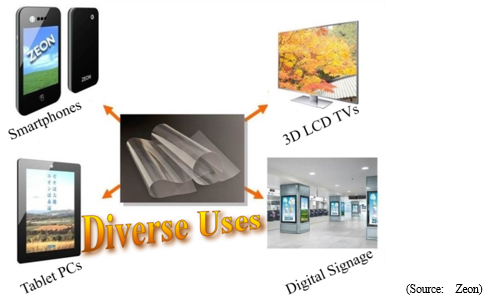 "Diagonally-stretched optical film" is also Zeon's world first development.
The OELD application as anti-reflection film is progressing, and demand for small- to medium-sized flat panel display applications is growing. In addition to the current plants in Takaoka and Himi (an annual output of 15 million square meters for optical film in total), the construction of a new plant in Tsuruga, Fukui Prefecture was completed in October 2013.
ZEOCOAT® is organic insulation material used in electronic devices such as cellphones, smartphones, and LCD televisions. ZEOCOAT® was successful in improving both the picture quality and reliability of displays because of its high transparency, extremely low water absorption and low gas generation properties. Zeon will aggressively expand its marketing efforts for OELDs, which will be thinner displays than LCD, thin-film transistors using new semiconductors, and flexible displays.
② Battery Materials
Zeon provides materials for lithium ion battery in this segment; anode / cathode binders, binder for functional layer (heat resistant separator), and sealant.
Currently, Li-ion batteries are widely used as a power source for mobile devices such as mobile phones and notebook computers. Due to the rapid popularization of smartphones, there is a strong demand for higher capacity batteries. Adoption for electric vehicles, including hybrid and plug-in hybrid cars, and industrial power sources (such as smart grids, etc.) also have begun, since it is lightweight, compact and can store a lot of energy. On the other hand, there was a problem that lifetime tends to decrease under high temperature usage.
The company has advanced the function of Li-ion battery binder and succeeded to develop an aqueous cathode binder, which greatly contributes to longer battery life. In addition, Zeon succeeded in commercializing anode binder, which can raise the storage capacity of Li-ion battery by 5% to 15%.
Zeon believes that its materials contribute to safety, long life and battery capacity increase of Li-ion batteries and contribute to the widespread of hybrid cars.
The company focused on the promising future of Li-ion batteries and worked on it for a long time. In this business segment for 2020, Zeon seeks to keep its top share in the Li-ion battery binder market, aims to expand the diffusion of new material functions that meet the needs of the application and propose functional materials to realize the next generation of new batteries.
"Diagonally-stretched optical film" is also Zeon's world first development.
The OELD application as anti-reflection film is progressing, and demand for small- to medium-sized flat panel display applications is growing. In addition to the current plants in Takaoka and Himi (an annual output of 15 million square meters for optical film in total), the construction of a new plant in Tsuruga, Fukui Prefecture was completed in October 2013.
ZEOCOAT® is organic insulation material used in electronic devices such as cellphones, smartphones, and LCD televisions. ZEOCOAT® was successful in improving both the picture quality and reliability of displays because of its high transparency, extremely low water absorption and low gas generation properties. Zeon will aggressively expand its marketing efforts for OELDs, which will be thinner displays than LCD, thin-film transistors using new semiconductors, and flexible displays.
② Battery Materials
Zeon provides materials for lithium ion battery in this segment; anode / cathode binders, binder for functional layer (heat resistant separator), and sealant.
Currently, Li-ion batteries are widely used as a power source for mobile devices such as mobile phones and notebook computers. Due to the rapid popularization of smartphones, there is a strong demand for higher capacity batteries. Adoption for electric vehicles, including hybrid and plug-in hybrid cars, and industrial power sources (such as smart grids, etc.) also have begun, since it is lightweight, compact and can store a lot of energy. On the other hand, there was a problem that lifetime tends to decrease under high temperature usage.
The company has advanced the function of Li-ion battery binder and succeeded to develop an aqueous cathode binder, which greatly contributes to longer battery life. In addition, Zeon succeeded in commercializing anode binder, which can raise the storage capacity of Li-ion battery by 5% to 15%.
Zeon believes that its materials contribute to safety, long life and battery capacity increase of Li-ion batteries and contribute to the widespread of hybrid cars.
The company focused on the promising future of Li-ion batteries and worked on it for a long time. In this business segment for 2020, Zeon seeks to keep its top share in the Li-ion battery binder market, aims to expand the diffusion of new material functions that meet the needs of the application and propose functional materials to realize the next generation of new batteries.
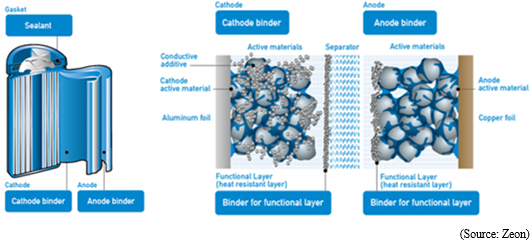 ③ Medical Device
The medical device market is relatively well insulated from fluctuations in the economy, and is anticipated to grow with the aging society in Japan and expansion in developing countries. Furthermore, medical device companies are subject to strict laws and regulations, and they need to submit approval applications to regulatory bodies. In addition, the need to develop relationships with healthcare professionals is critical and the subsequent high barriers to entry makes this a highly attractive market.
Along with the start of development of artificial kidneys in 1974, Zeon aggressively promoted its medical device business. In 1989, a subsidiary Zeon Medical Inc. was established to conduct development, manufacturing, sales and all other functions of the medical field for the Zeon Group. Zeon has shown bountiful development track record both in gastroenterology and cardiovascular area. The Offset Balloon Catheter as a means of differentiation in the gallstone removal process and with Japan's first biliary covered stent Zeostent Covered in the area of gastroenterology products, and the world's smallest diameter XEMEX IABP Balloon PLUS as a device to aid the heartbeat at times of acute myocardial infarction in the area of cardiovascular products. ③ Medical Device
The medical device market is relatively well insulated from fluctuations in the economy, and is anticipated to grow with the aging society in Japan and expansion in developing countries. Furthermore, medical device companies are subject to strict laws and regulations, and they need to submit approval applications to regulatory bodies. In addition, the need to develop relationships with healthcare professionals is critical and the subsequent high barriers to entry makes this a highly attractive market.
Along with the start of development of artificial kidneys in 1974, Zeon aggressively promoted its medical device business. In 1989, a subsidiary Zeon Medical Inc. was established to conduct development, manufacturing, sales and all other functions of the medical field for the Zeon Group. Zeon has shown bountiful development track record both in gastroenterology and cardiovascular area. The Offset Balloon Catheter as a means of differentiation in the gallstone removal process and with Japan's first biliary covered stent Zeostent Covered in the area of gastroenterology products, and the world's smallest diameter XEMEX IABP Balloon PLUS as a device to aid the heartbeat at times of acute myocardial infarction in the area of cardiovascular products.
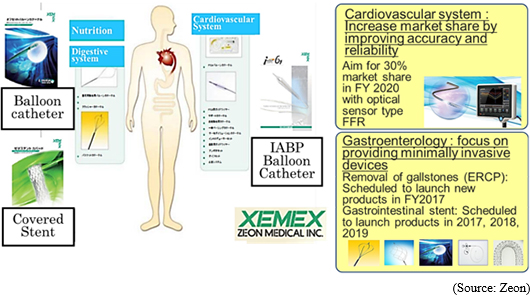 Currently Zeon is focusing efforts in the development of devices that eliminate gallstone pain by removal of gallstones. Zeon has a lineup of products that can remove gallstones ranging from extremely large stones to sludge and sand with products such as XEMEX Crusher Catheter, XEMEX Basket Catheter NT, Extraction Balloon Catheter, and is aiming at a 50% share of the gallstone removal market.
In March 2016, the Company launched the world's first optical sensor FFR device as a type of guide wire. Because it uses an optical fiber sensor, mistaken readings of blood pressure measurements rarely occur. The operability as a guide wire has also gained a high evaluation and Zeon is aiming for a 30% share of the Japanese market by 2020.
④ Chemical Business
Zeon deals in specialty chemicals that use derivatives from C5 fraction, such as synthesized fragrances for cosmetics and flavor used in foods, solvents and plant growth regulator. The Company holds the world's top share of the synthesized fragrances in green note. They provide a wide range of specialty products including ingredients for intermediary bodies used in medical and agricultural chemicals, alternative CFCs solvents, cleaning agents, urethane expanding agent, and functional ether agents.
【New Specialty Materials Development: ~Carbon Nano Tube (CNT)~ 】
Aggressive R&D activities have allowed Zeon to launch various new materials into the market, and particularly high expectation is in the development of "single-wall carbon nanotubes (CNT)".
① What is Single-Walled CNT?
Carbon Nanotubes (CNTs) are cylindrical nanostructure formed by hexagonal lattice of carbon atoms. In 1993, Sumio Iijima, Ph.D., head of the Applied Nanotube Research Center of the National Institute of Advanced Industrial Science and Technology (AIST), discovered this structure for the first time in the world and named Carbon Nanotubes (CNTs). CNTs are categorized into single-walled and multiple-walled CNTs. Multiple-walled CNT is relatively easy to manufacture and the developments for commercial applications already started.
Currently Zeon is focusing efforts in the development of devices that eliminate gallstone pain by removal of gallstones. Zeon has a lineup of products that can remove gallstones ranging from extremely large stones to sludge and sand with products such as XEMEX Crusher Catheter, XEMEX Basket Catheter NT, Extraction Balloon Catheter, and is aiming at a 50% share of the gallstone removal market.
In March 2016, the Company launched the world's first optical sensor FFR device as a type of guide wire. Because it uses an optical fiber sensor, mistaken readings of blood pressure measurements rarely occur. The operability as a guide wire has also gained a high evaluation and Zeon is aiming for a 30% share of the Japanese market by 2020.
④ Chemical Business
Zeon deals in specialty chemicals that use derivatives from C5 fraction, such as synthesized fragrances for cosmetics and flavor used in foods, solvents and plant growth regulator. The Company holds the world's top share of the synthesized fragrances in green note. They provide a wide range of specialty products including ingredients for intermediary bodies used in medical and agricultural chemicals, alternative CFCs solvents, cleaning agents, urethane expanding agent, and functional ether agents.
【New Specialty Materials Development: ~Carbon Nano Tube (CNT)~ 】
Aggressive R&D activities have allowed Zeon to launch various new materials into the market, and particularly high expectation is in the development of "single-wall carbon nanotubes (CNT)".
① What is Single-Walled CNT?
Carbon Nanotubes (CNTs) are cylindrical nanostructure formed by hexagonal lattice of carbon atoms. In 1993, Sumio Iijima, Ph.D., head of the Applied Nanotube Research Center of the National Institute of Advanced Industrial Science and Technology (AIST), discovered this structure for the first time in the world and named Carbon Nanotubes (CNTs). CNTs are categorized into single-walled and multiple-walled CNTs. Multiple-walled CNT is relatively easy to manufacture and the developments for commercial applications already started.
 At the same time, single-walled CNT exhibits the following properties and is superior to multiple-walled CNT:
- 20 times stronger than steel
- 10 times more heat conductive than copper
- Half as dense as aluminum
- 10 times the electron mobility of silicon
- lightweight but highly flexible
- has extremely high electric-and heat-conductivity properties
Possible CNT applications are electrical conductivity assistance agent in Li-ion batteries, transparent conductive film used in electronic paper and ultra-thin touch panel because of its high elasticity and strength, and as a thermal interface material. Because of its ability to absorb a wide spectrum of light, practical applications of single-walled CNT are being promoted in the area of electromagnetic wave absorbing materials for use in a wide range of fields including energy, electronics, structural materials, and specialty materials.
At the same time, single-walled CNT exhibits the following properties and is superior to multiple-walled CNT:
- 20 times stronger than steel
- 10 times more heat conductive than copper
- Half as dense as aluminum
- 10 times the electron mobility of silicon
- lightweight but highly flexible
- has extremely high electric-and heat-conductivity properties
Possible CNT applications are electrical conductivity assistance agent in Li-ion batteries, transparent conductive film used in electronic paper and ultra-thin touch panel because of its high elasticity and strength, and as a thermal interface material. Because of its ability to absorb a wide spectrum of light, practical applications of single-walled CNT are being promoted in the area of electromagnetic wave absorbing materials for use in a wide range of fields including energy, electronics, structural materials, and specialty materials.
 Conventional single-walled CNT has several major issues including high levels of impurities, low levels of productivity and high manufacturing costs, which are about several tens of thousands to hundreds of thousands of yen per gram.
② Zeon's Efforts and Position
Against this backdrop, the AIST and five companies* jointly established the technological consortium Technology Research Association for Single-Walled Carbon Nanotubes in May 2010 (*Zeon, NEC Corporation, Toray Industries, Teijin Limited, and Sumitomo Precision Products Co., Ltd.). The consortium aims at establishing technologies that are necessary for the commercialization of new products using single-walled CNT developed in Japan with its numerous superior qualities in response to the worldwide social demands to realize a low-carbon society.
Using the synthesizing technology super growth method developed by Dr. Kenji Hata (Ph.D.) of the AIST as a base, the above-mentioned consortium has been conducting R&D for mass production and application development for compound materials at a validation plant that was established in December 2010 on the premises of the Tsukuba Center of the AIST. Among the main reasons that the AIST Nanotube Application Research Center selected Zeon to become its partner were the impressive track record and results obtained by Kohei Arakawa, Zeon's former Managing Director, as a personnel in CNT R&D. Furthermore, the fact that the consortium director is Zeon President Furukawa reflects the importance of Zeon in this project to realize commercial applications of single-walled CNT.
③ Future Endeavors
Having established the mass production technology based on the super growth method, Zeon completed the CNT production facility and started mass production, the first in the world in November 2015 in its Tokuyama plant at Shunan-city, Yamaguchi Prefecture.
Zeon is the only company in the world that has established mass production technologies for single-wall CNT. In addition to those companies within the consortium mentioned above, about 100 companies around the world request for its product samples. Consequently, shipments of samples have already begun. Zeon has also begun to propose practical applications of this product.
At the same time, single-wall CNT is a type of nanomaterial that is extremely small and fiber shape. Therefore, there is a concern that it may have some impact upon biological processes depending upon its size and shape. Currently, the AIST is conducting standardization of the evaluation process, and activities for the OECD endpoint measurement are being conducted, with global standardization and legal and regulatory aspects being considered.
<Other Business>
The combination liquid for Reaction Injection Molding (RIM) and molded items using the ingredient dicyclopentadiene (DCPD) as a raw material.
(Characteristics and Strengths)
1. World's Leading Creative Technology Development Capability
The GPB method used to manufacture butadiene from C4 fraction is the most important development in Japan's postwar history of chemicals, and is licensed to 49 plants in 19 countries around the world.
In addition, the Mizushima Plant is the world's only plant with GPI method to extract high-purity isoprene and other effective substances from C5 fraction. This Zeon's GPI method is a completely unique technology, which is not provided to other companies. Zeon is able to acquire basic ingredients used in synthesized fragrances and petroleum resin.
These two technologies represent the creative technological capabilities that are among the strengths of Zeon. They also are highly regarded and have received numerous awards in the global markets. With regard to technologies, Zeon has received 48 awards since 1960 including the GPB and GPI methods, in addition to 26 awards since 1982 for its environment conservation and safety efforts.
2. High Worldwide Share
Zetpol®, ZEONEX®, and ZEONOR® are representative of the products born from Zeon's highly creative technologies, which have allowed it to acquire high shares of worldwide markets. In addition, their Leaf alcohol for in cosmetics and food flavorings and NBR latex for cosmetic puffs have the world's top share.
3. R&D Structure that Continues to Yield Creative Technologies
Zeon seeks to conduct R&D activities based upon its basic corporate philosophy of “developing creative technologies in special fields of strength that enables Zeon to contribute to society by generating the world's leading businesses."
The Company's main R&D center is located in Kawasaki City, Kanagawa Prefecture. Zeon has also established the Precision Optics Laboratory and Medical Laboratory at the Takaoka Plant, the Chemical Product Research Facility at the Yonezawa Plant and at the Mizushima Plant and the Toner Research Facility at the Tokuyama Plant for more efficient R&D activities to be conducted closer to the manufacturing sites. The technical support bases are in the U.S., Europe, Singapore, and China.
The R&D personnel are never satisfied with the current conditions, and always keep conscious of the threat that their competitors pose in their research activities. Furthermore, Zeon bases its valuation on a positive point awarding system that places high priority on speed and creativity. R&D expenses were formerly measured as a percentage of sales, but now it has established an annual value amount of ¥12.0 ~ ¥13.0 billion as an investment budget to ensure that stable R&D activities can be maintained in the future.
Conventional single-walled CNT has several major issues including high levels of impurities, low levels of productivity and high manufacturing costs, which are about several tens of thousands to hundreds of thousands of yen per gram.
② Zeon's Efforts and Position
Against this backdrop, the AIST and five companies* jointly established the technological consortium Technology Research Association for Single-Walled Carbon Nanotubes in May 2010 (*Zeon, NEC Corporation, Toray Industries, Teijin Limited, and Sumitomo Precision Products Co., Ltd.). The consortium aims at establishing technologies that are necessary for the commercialization of new products using single-walled CNT developed in Japan with its numerous superior qualities in response to the worldwide social demands to realize a low-carbon society.
Using the synthesizing technology super growth method developed by Dr. Kenji Hata (Ph.D.) of the AIST as a base, the above-mentioned consortium has been conducting R&D for mass production and application development for compound materials at a validation plant that was established in December 2010 on the premises of the Tsukuba Center of the AIST. Among the main reasons that the AIST Nanotube Application Research Center selected Zeon to become its partner were the impressive track record and results obtained by Kohei Arakawa, Zeon's former Managing Director, as a personnel in CNT R&D. Furthermore, the fact that the consortium director is Zeon President Furukawa reflects the importance of Zeon in this project to realize commercial applications of single-walled CNT.
③ Future Endeavors
Having established the mass production technology based on the super growth method, Zeon completed the CNT production facility and started mass production, the first in the world in November 2015 in its Tokuyama plant at Shunan-city, Yamaguchi Prefecture.
Zeon is the only company in the world that has established mass production technologies for single-wall CNT. In addition to those companies within the consortium mentioned above, about 100 companies around the world request for its product samples. Consequently, shipments of samples have already begun. Zeon has also begun to propose practical applications of this product.
At the same time, single-wall CNT is a type of nanomaterial that is extremely small and fiber shape. Therefore, there is a concern that it may have some impact upon biological processes depending upon its size and shape. Currently, the AIST is conducting standardization of the evaluation process, and activities for the OECD endpoint measurement are being conducted, with global standardization and legal and regulatory aspects being considered.
<Other Business>
The combination liquid for Reaction Injection Molding (RIM) and molded items using the ingredient dicyclopentadiene (DCPD) as a raw material.
(Characteristics and Strengths)
1. World's Leading Creative Technology Development Capability
The GPB method used to manufacture butadiene from C4 fraction is the most important development in Japan's postwar history of chemicals, and is licensed to 49 plants in 19 countries around the world.
In addition, the Mizushima Plant is the world's only plant with GPI method to extract high-purity isoprene and other effective substances from C5 fraction. This Zeon's GPI method is a completely unique technology, which is not provided to other companies. Zeon is able to acquire basic ingredients used in synthesized fragrances and petroleum resin.
These two technologies represent the creative technological capabilities that are among the strengths of Zeon. They also are highly regarded and have received numerous awards in the global markets. With regard to technologies, Zeon has received 48 awards since 1960 including the GPB and GPI methods, in addition to 26 awards since 1982 for its environment conservation and safety efforts.
2. High Worldwide Share
Zetpol®, ZEONEX®, and ZEONOR® are representative of the products born from Zeon's highly creative technologies, which have allowed it to acquire high shares of worldwide markets. In addition, their Leaf alcohol for in cosmetics and food flavorings and NBR latex for cosmetic puffs have the world's top share.
3. R&D Structure that Continues to Yield Creative Technologies
Zeon seeks to conduct R&D activities based upon its basic corporate philosophy of “developing creative technologies in special fields of strength that enables Zeon to contribute to society by generating the world's leading businesses."
The Company's main R&D center is located in Kawasaki City, Kanagawa Prefecture. Zeon has also established the Precision Optics Laboratory and Medical Laboratory at the Takaoka Plant, the Chemical Product Research Facility at the Yonezawa Plant and at the Mizushima Plant and the Toner Research Facility at the Tokuyama Plant for more efficient R&D activities to be conducted closer to the manufacturing sites. The technical support bases are in the U.S., Europe, Singapore, and China.
The R&D personnel are never satisfied with the current conditions, and always keep conscious of the threat that their competitors pose in their research activities. Furthermore, Zeon bases its valuation on a positive point awarding system that places high priority on speed and creativity. R&D expenses were formerly measured as a percentage of sales, but now it has established an annual value amount of ¥12.0 ~ ¥13.0 billion as an investment budget to ensure that stable R&D activities can be maintained in the future.
|
| Fiscal Year March 2018 Earnings Results |
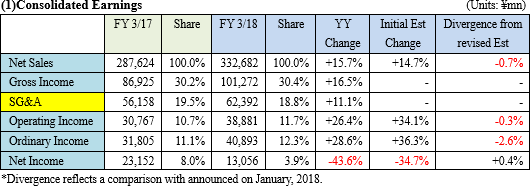 Sales and profit grew by double digits, because quantities increased and prices were raised.
Sales were 332.7 billion yen, up 45.1 billion yen year on year. The increase in quantities accounted for an increment of 37.2 billion yen, while the rise in prices made up an increment of 4.6 billion yen. As for elastomers, general-purpose rubber and specialty rubber, etc. for export sold well. As for specialty materials, the sales of diagonally-stretched films for small and medium-sized displays and battery materials were healthy. Operating income grew 8.1 billion yen year on year to 38.9 billion yen. The increase in quantities accounted for an increment of 10.2 billion yen, and the rise in prices made up an increment of 4.6 billion yen. The increase in the price of domestic naphtha reduced profit by 3.8 billion yen.
Ordinary income increased 9.1 billion yen to 40.9 billion yen. Exchange loss dropped 600 million yen.
Sales, operating income, and ordinary income marked record highs, but net income declined, because an impairment loss of 14.7 billion yen was posted as an extraordinary loss in the consolidated subsidiary Zeon Chemicals Singapore Pte. Ltd. in Singapore, as its long-term business plan was revised to cope with the changes in the business environment and the book value of fixed assets (production equipment, etc.) owned by the company was reduced to the recoupable amount because there was a sign of impairment loss.
The results exceeded the initial forecast, and were in line with the second revised forecast as a whole. Sales and profit grew by double digits, because quantities increased and prices were raised.
Sales were 332.7 billion yen, up 45.1 billion yen year on year. The increase in quantities accounted for an increment of 37.2 billion yen, while the rise in prices made up an increment of 4.6 billion yen. As for elastomers, general-purpose rubber and specialty rubber, etc. for export sold well. As for specialty materials, the sales of diagonally-stretched films for small and medium-sized displays and battery materials were healthy. Operating income grew 8.1 billion yen year on year to 38.9 billion yen. The increase in quantities accounted for an increment of 10.2 billion yen, and the rise in prices made up an increment of 4.6 billion yen. The increase in the price of domestic naphtha reduced profit by 3.8 billion yen.
Ordinary income increased 9.1 billion yen to 40.9 billion yen. Exchange loss dropped 600 million yen.
Sales, operating income, and ordinary income marked record highs, but net income declined, because an impairment loss of 14.7 billion yen was posted as an extraordinary loss in the consolidated subsidiary Zeon Chemicals Singapore Pte. Ltd. in Singapore, as its long-term business plan was revised to cope with the changes in the business environment and the book value of fixed assets (production equipment, etc.) owned by the company was reduced to the recoupable amount because there was a sign of impairment loss.
The results exceeded the initial forecast, and were in line with the second revised forecast as a whole.
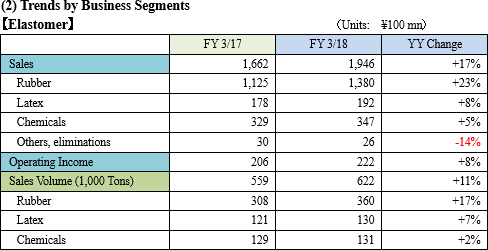 Sales and profit grew. Operating margin dropped 1 point from 12.4% in the previous term to 11.4%.
The sales volume of rubber increased 17%. The overseas demand for both general-purpose and specialty rubbers was strong, and the price effect was significant. The sales volume of general-purpose rubber rose 20%. The growth in Japan was slight, but overseas growth rate was 33%, because the performance of SSBR was healthy and the market was thriving. The sales of specialty rubber increased 5%. The performance in Japan was on a plateau, while overseas sales grew 8%.
Specialty rubber accounted for 27% in quantity, down 3%, and 51% in price, down 3%.
As for latex, the materials for gloves to be exported sold well.
Sales and profit grew. Operating margin dropped 1 point from 12.4% in the previous term to 11.4%.
The sales volume of rubber increased 17%. The overseas demand for both general-purpose and specialty rubbers was strong, and the price effect was significant. The sales volume of general-purpose rubber rose 20%. The growth in Japan was slight, but overseas growth rate was 33%, because the performance of SSBR was healthy and the market was thriving. The sales of specialty rubber increased 5%. The performance in Japan was on a plateau, while overseas sales grew 8%.
Specialty rubber accounted for 27% in quantity, down 3%, and 51% in price, down 3%.
As for latex, the materials for gloves to be exported sold well.
 Sales and profit grew. Operating margin rose 6.3 points from 13.1% in the previous term to 19.4%.
In the segment of specialty chemicals, the sales of electronic materials increased 15% year on year, as the sales of etching gas, etc. rose, and the sales of battery materials grew as high as 34% thanks to the favorable performance of products for in-vehicle devices. The sales of chemical products, too, increased 12%, although the sales declined in the first half. The export of synthetic fragrances was healthy. The sales of toners grew 2% year on year.
In the segment of specialty plastics, the sales of COP resin rose 7%, although the sales declined until the third quarter. The sales of optical films increased 18%, because the products for small and medium-sized displays sold well. Sales volume rose 8% year on year. The ratio of sales of optical films for small and medium-sized displays rose considerably from 18% in the previous term to 28%.
Sales and profit grew. Operating margin rose 6.3 points from 13.1% in the previous term to 19.4%.
In the segment of specialty chemicals, the sales of electronic materials increased 15% year on year, as the sales of etching gas, etc. rose, and the sales of battery materials grew as high as 34% thanks to the favorable performance of products for in-vehicle devices. The sales of chemical products, too, increased 12%, although the sales declined in the first half. The export of synthetic fragrances was healthy. The sales of toners grew 2% year on year.
In the segment of specialty plastics, the sales of COP resin rose 7%, although the sales declined until the third quarter. The sales of optical films increased 18%, because the products for small and medium-sized displays sold well. Sales volume rose 8% year on year. The ratio of sales of optical films for small and medium-sized displays rose considerably from 18% in the previous term to 28%.
 Sales and profit increased. Operating income margin rose 0.1 points year on year from 5.8% to 5.9%.
Sales and profit increased. Operating income margin rose 0.1 points year on year from 5.8% to 5.9%.
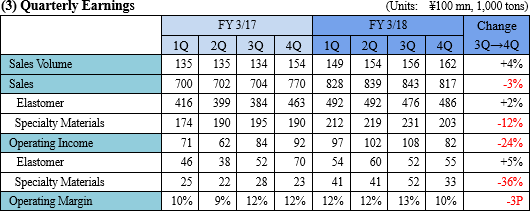 Cumulative sales and profit increased, but quarterly sales and profit dropped from the previous quarter. The performance of elastomers was healthy, but that of specialty materials was somewhat sluggish. The factor of quantity sold decreased sales by 2 billion yen, the price factor diminished sales by 300 million yen, and the exchange rate factor dropped sales by 400 million yen. The factor of quantity sold and the price factor decreased operating income by 500 million yen and 300 million yen, respectively. The cost factor and the exchange rate factor diminished operating income by 1 billion yen and 400 million yen, respectively.
Cumulative sales and profit increased, but quarterly sales and profit dropped from the previous quarter. The performance of elastomers was healthy, but that of specialty materials was somewhat sluggish. The factor of quantity sold decreased sales by 2 billion yen, the price factor diminished sales by 300 million yen, and the exchange rate factor dropped sales by 400 million yen. The factor of quantity sold and the price factor decreased operating income by 500 million yen and 300 million yen, respectively. The cost factor and the exchange rate factor diminished operating income by 1 billion yen and 400 million yen, respectively.
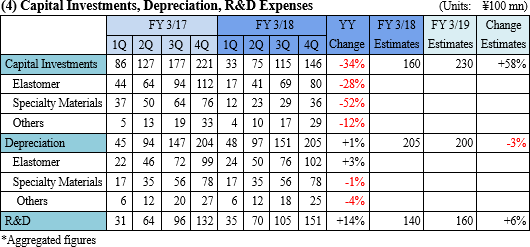 Capital expenditure did not reach the estimate revised in the third quarter: 16 billion yen. The company aims to increase it this term.
Capital expenditure did not reach the estimate revised in the third quarter: 16 billion yen. The company aims to increase it this term.
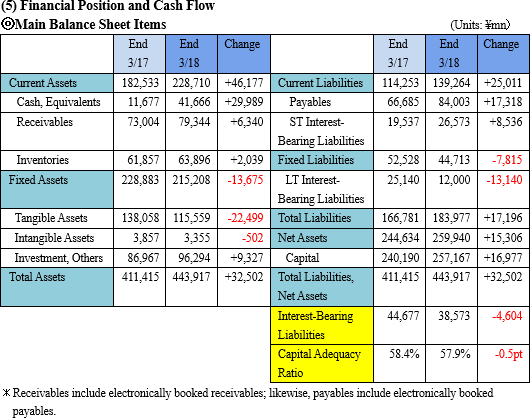 Current assets grew 46.1 billion yen from the end of the previous term, due to the increases in cash & deposits and receivables induced by sales growth. Total fixed assets decreased 13.6 billion yen from the end of the previous term, as investments and other assets rose 9.3 billion yen due to the increase in valuation of investment securities caused by the rise in share price, but tangible assets dropped due to the posting of impairment loss. Total assets rose 32.5 billion yen from the end of the previous term.
Total liabilities augmented 17.1 billion yen from the end of the previous term, as interest-bearing debts shrank 4.6 billion yen, but payables increased 17.3 billion yen. Net assets grew 15.3 billion yen, due to the increase in retained earnings and valuation difference on available-for-sale securities. As a result, capital adequacy ratio dropped 0.5 points from the end of the previous term to 57.9%.
Current assets grew 46.1 billion yen from the end of the previous term, due to the increases in cash & deposits and receivables induced by sales growth. Total fixed assets decreased 13.6 billion yen from the end of the previous term, as investments and other assets rose 9.3 billion yen due to the increase in valuation of investment securities caused by the rise in share price, but tangible assets dropped due to the posting of impairment loss. Total assets rose 32.5 billion yen from the end of the previous term.
Total liabilities augmented 17.1 billion yen from the end of the previous term, as interest-bearing debts shrank 4.6 billion yen, but payables increased 17.3 billion yen. Net assets grew 15.3 billion yen, due to the increase in retained earnings and valuation difference on available-for-sale securities. As a result, capital adequacy ratio dropped 0.5 points from the end of the previous term to 57.9%.
 The surplus of operating CF increased, as net income before taxes and other adjustments decreased, but impairment loss was posted. The deficit of investing CF shrank as purchase of property, plant and equipment declined. The surplus of free CF grew.
The deficit of financing CF decreased, as repayments of long-term loans payable declined. The cash position improved.
The surplus of operating CF increased, as net income before taxes and other adjustments decreased, but impairment loss was posted. The deficit of investing CF shrank as purchase of property, plant and equipment declined. The surplus of free CF grew.
The deficit of financing CF decreased, as repayments of long-term loans payable declined. The cash position improved.
|
| Fiscal Year March 2019 Earnings Estimates |
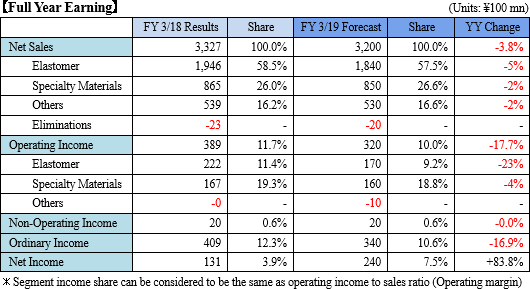  Due to the yen appreciation, sales and profit are estimated to decrease.
Sales are estimated to decrease 3.8% year on year to 320 billion yen, while operating income is projected to decline 17.7% to 32 billion yen. Operating margin is estimated to decline 1.7 points to 10.0%. The yen is forecasted to get 10% stronger against the dollar. For both businesses, sales and profit are estimated to decrease.
Since impairment loss was posted in the previous term, net income is projected to rise considerably.
The dividend amount is to be 19.00 yen/share, up 2 yen/share from the previous term. The estimated payout ratio is 17.6%. Due to the yen appreciation, sales and profit are estimated to decrease.
Sales are estimated to decrease 3.8% year on year to 320 billion yen, while operating income is projected to decline 17.7% to 32 billion yen. Operating margin is estimated to decline 1.7 points to 10.0%. The yen is forecasted to get 10% stronger against the dollar. For both businesses, sales and profit are estimated to decrease.
Since impairment loss was posted in the previous term, net income is projected to rise considerably.
The dividend amount is to be 19.00 yen/share, up 2 yen/share from the previous term. The estimated payout ratio is 17.6%.
|
| "New Mid-term Management Plan SZ-20 Phase III" |
|
Progress of "New Mid-term Management Plan SZ-20 Phase III" covering a four-year period beginning from fiscal year March 2018 is as follows.
  ① Elastomer Business
◎SSBR:Exploration
By combining the polymer modification and production technologies of Sumitomo Chemical and Zeon, the company aims to improve "wet grip," "mileage," and "abrasion resistance" of tires in order to meet the strong needs, and seize the leading position in the world.
The solution-polymerized rubber of Zeon was adopted for the latest studless tires of the Yokohama Rubber Co., Ltd.
The sales volume of SSBR is estimated to increase about 1.5 times between 2017 and 2020.
◎Specialty Rubber: Reinforcement
The specialty cross-linked Zetpol®, whose gasket heat resistance is higher than that of conventional products, is highly evaluated, and is to be adopted for the fuel hoses of four-wheeled cars, and is increasingly used for oil seals.
The production output of Kawasaki Plant will be enhanced by Sep. 2019, and the company aims to boost sales volume about 2.5 times between fiscal 2016 and fiscal 2019.
◎Latex: Acceleration of business creation and development of new products
The company aims to expand sales by releasing new products in the global market of working gloves, which is steadily growing at an annual rate of 5-7%. The company aims to significantly increase the sales of the latex for working glove at an annual rate of about 30%, mainly in overseas markets.
◎SIS:Reinforcement
By further promoting asymmetric SIS that has superior strength and elasticity, the company will further expand the domain of SIS, while differentiating products, such as flexography, protective films, adhesive tapes, and hot-melt adhesives, in addition to elastic films and adhesive labels.
The company aims to expand the sales volume of asymmetric SIS about 6 times by fiscal 2020 between fiscal 2017 and fiscal 2020.
◎PSC (powder slash compound): Solution
The company responds to the expansion of the market based on its three facilities in Japan, China, and Mexico.
The first phase of construction of Mexico Plant, whose production capacity is 1,200 tons per year, was completed, and its operation began in January 2018.
The second phase of construction, whose production capacity is 1,200 tons, is scheduled to be in operation from 2020. Then, global production capacity will be 6,800 tons.
Global sales are estimated to double between 2017 and 2020.
② Specialty Material Business
◎COP:Reinforcement
In the Chinese market, investment is very active, as the line width of device processing became narrower and three-dimensional because smartphones and in-vehicle devices became sophisticated and large-capacity.
Zeon will promote the use for semiconductor containers, by utilizing the features of ZEONEX® and ZEONOR®, such as "a low content of impurities" and "low water vapor transmission."
The characteristics of ZEONEX®, including low moisture absorption, high transparency, precise optical property, and precise formability, are suited for the materials of lenses used for HMD* terminals, whose production amount is growing in parallel with the popularization and spread of virtual reality (VR) and augmented reality (AR).
As the production amount of HMD terminals will grow steeply, the sales volume of Zeon's materials for lenses used for HMD terminals is expected to double between fiscal 2016 and fiscal 2018.
*HMD terminals
HMD is the abbreviation is Head Mount Display. This means a display mounted on the head just like a goggle, a helmet, and eyeglasses. It is suited for playing the moving pictures of VR and AR.
◎ZeonorFilm:Reinforcement
In the market of small and medium-sized displays, the products of Zeon are increasingly adopted for both liquid crystal displays (LCDs) and organic light emitting diodes (OLEDs). The company will keep promoting the adoption for retardation films of OLEDs.
The company is developing "ZC-Film," which is highly flexible, for foldable devices.
◎Battery materials: Solution
The company will enrich products further to expand its business.
The sales of battery materials exceeded the estimate in the period of the previous mid-term plan, because the company increased products for automobiles as the capacity of Li-ion batteries augmented.
The sales grew 18.5 times in China (whose market scale grew 9.3 times) and 7.2 times in South Korea (whose market scale rose 4.5 times) from 2010.
Major automobile manufacturers plan to expand the sales of electric vehicles (EVs).
As the company started its business with sealants, it will actively propose the adoption of materials (binders) that can achieve safety, long service life, and high output, and aims at more expansion.
◎Medical devices: Accelerate new business creation and product development
The optical sensor FFR, which was released in fiscal year March 2017, is increasingly adopted because of its high reliability. Its market share is expected to increase from 14% in 2017 to 30% in 2020.
(FFR means Fractional Flow Reserve, which is an indicator for estimating how much blood circulation is hindered by stenosis inside a coronary artery.)
As minimally invasive treatment, which does not hurt patients' bodies so much, became popular, the company released a large-diameter endoscopic retrograde cholangiopancreatography balloon in fiscal 2017, and plans to release a new endoscopic retrograde cholangiopancreatography balloon and a bile duct stent in fiscal 2018.
◎Carbon nanotubes (CNT): Accelerate new business creation and product development
In February 2017, the company, National Institute of Advanced Industrial Science and Technology (AIST), which is a National R&D Agency, and Sunarrow Limited jointly established Zeon Sunarrow AIST CNT Composite Material Research Center, and have been proceeding with the research into CNT composites. This effort led to the release of the following product.
*Unbreakable electromagnetic shielding caulking material that is excellent in weather-stripping property and metal adhesiveness (released in Feb. 2018)
The company developed an electromagnetic shielding caulking material by adding single-walled carbon nanotubes produced with the super growth method and dispersing them in liquid rubber that hardens at room temperatures under an air atmosphere.
Outline
This caulking material can be applied and fill the gaps and grooves of shielding materials, such as metal, with high adhesion and hardens at room temperatures under an air atmosphere. After hardening, it is highly adhesive to metal, blocks electromagnetic waves, and absorbs the vibrations and distortions of the gaps and grooves between shielding materials caused by the vibrations and minor deformations of the shielding materials.
Social background
The number of electronic devices that use electromagnetic waves for communications has been increasing, as wireless communications technologies have been advanced. Accordingly, there are growing risks of the malfunction of these electronic devices caused by ambient electromagnetic waves and leakage of information via electromagnetic waves they emit. In order to mitigate these risks, it is necessary to block unrequired electromagnetic waves emitted by electronic devices, and electromagnetically isolate the space where electronic devices are placed.
For example, electromagnetic wave shielding materials are used for the floors, walls, ceilings, windows, doors, etc. of a room in order to isolate the electromagnetic waves inside the room, but the gaps between them would allow the leak of electromagnetic waves, degrading the shielding property. Therefore, it was required to develop an unbreakable electromagnetic shielding caulking material that is excellent in weather-stripping property and metal adhesiveness.
The company participated in the 17th International Nanotechnology Exhibition & Conference in Feb. 2018, supplying samples for evaluation. ① Elastomer Business
◎SSBR:Exploration
By combining the polymer modification and production technologies of Sumitomo Chemical and Zeon, the company aims to improve "wet grip," "mileage," and "abrasion resistance" of tires in order to meet the strong needs, and seize the leading position in the world.
The solution-polymerized rubber of Zeon was adopted for the latest studless tires of the Yokohama Rubber Co., Ltd.
The sales volume of SSBR is estimated to increase about 1.5 times between 2017 and 2020.
◎Specialty Rubber: Reinforcement
The specialty cross-linked Zetpol®, whose gasket heat resistance is higher than that of conventional products, is highly evaluated, and is to be adopted for the fuel hoses of four-wheeled cars, and is increasingly used for oil seals.
The production output of Kawasaki Plant will be enhanced by Sep. 2019, and the company aims to boost sales volume about 2.5 times between fiscal 2016 and fiscal 2019.
◎Latex: Acceleration of business creation and development of new products
The company aims to expand sales by releasing new products in the global market of working gloves, which is steadily growing at an annual rate of 5-7%. The company aims to significantly increase the sales of the latex for working glove at an annual rate of about 30%, mainly in overseas markets.
◎SIS:Reinforcement
By further promoting asymmetric SIS that has superior strength and elasticity, the company will further expand the domain of SIS, while differentiating products, such as flexography, protective films, adhesive tapes, and hot-melt adhesives, in addition to elastic films and adhesive labels.
The company aims to expand the sales volume of asymmetric SIS about 6 times by fiscal 2020 between fiscal 2017 and fiscal 2020.
◎PSC (powder slash compound): Solution
The company responds to the expansion of the market based on its three facilities in Japan, China, and Mexico.
The first phase of construction of Mexico Plant, whose production capacity is 1,200 tons per year, was completed, and its operation began in January 2018.
The second phase of construction, whose production capacity is 1,200 tons, is scheduled to be in operation from 2020. Then, global production capacity will be 6,800 tons.
Global sales are estimated to double between 2017 and 2020.
② Specialty Material Business
◎COP:Reinforcement
In the Chinese market, investment is very active, as the line width of device processing became narrower and three-dimensional because smartphones and in-vehicle devices became sophisticated and large-capacity.
Zeon will promote the use for semiconductor containers, by utilizing the features of ZEONEX® and ZEONOR®, such as "a low content of impurities" and "low water vapor transmission."
The characteristics of ZEONEX®, including low moisture absorption, high transparency, precise optical property, and precise formability, are suited for the materials of lenses used for HMD* terminals, whose production amount is growing in parallel with the popularization and spread of virtual reality (VR) and augmented reality (AR).
As the production amount of HMD terminals will grow steeply, the sales volume of Zeon's materials for lenses used for HMD terminals is expected to double between fiscal 2016 and fiscal 2018.
*HMD terminals
HMD is the abbreviation is Head Mount Display. This means a display mounted on the head just like a goggle, a helmet, and eyeglasses. It is suited for playing the moving pictures of VR and AR.
◎ZeonorFilm:Reinforcement
In the market of small and medium-sized displays, the products of Zeon are increasingly adopted for both liquid crystal displays (LCDs) and organic light emitting diodes (OLEDs). The company will keep promoting the adoption for retardation films of OLEDs.
The company is developing "ZC-Film," which is highly flexible, for foldable devices.
◎Battery materials: Solution
The company will enrich products further to expand its business.
The sales of battery materials exceeded the estimate in the period of the previous mid-term plan, because the company increased products for automobiles as the capacity of Li-ion batteries augmented.
The sales grew 18.5 times in China (whose market scale grew 9.3 times) and 7.2 times in South Korea (whose market scale rose 4.5 times) from 2010.
Major automobile manufacturers plan to expand the sales of electric vehicles (EVs).
As the company started its business with sealants, it will actively propose the adoption of materials (binders) that can achieve safety, long service life, and high output, and aims at more expansion.
◎Medical devices: Accelerate new business creation and product development
The optical sensor FFR, which was released in fiscal year March 2017, is increasingly adopted because of its high reliability. Its market share is expected to increase from 14% in 2017 to 30% in 2020.
(FFR means Fractional Flow Reserve, which is an indicator for estimating how much blood circulation is hindered by stenosis inside a coronary artery.)
As minimally invasive treatment, which does not hurt patients' bodies so much, became popular, the company released a large-diameter endoscopic retrograde cholangiopancreatography balloon in fiscal 2017, and plans to release a new endoscopic retrograde cholangiopancreatography balloon and a bile duct stent in fiscal 2018.
◎Carbon nanotubes (CNT): Accelerate new business creation and product development
In February 2017, the company, National Institute of Advanced Industrial Science and Technology (AIST), which is a National R&D Agency, and Sunarrow Limited jointly established Zeon Sunarrow AIST CNT Composite Material Research Center, and have been proceeding with the research into CNT composites. This effort led to the release of the following product.
*Unbreakable electromagnetic shielding caulking material that is excellent in weather-stripping property and metal adhesiveness (released in Feb. 2018)
The company developed an electromagnetic shielding caulking material by adding single-walled carbon nanotubes produced with the super growth method and dispersing them in liquid rubber that hardens at room temperatures under an air atmosphere.
Outline
This caulking material can be applied and fill the gaps and grooves of shielding materials, such as metal, with high adhesion and hardens at room temperatures under an air atmosphere. After hardening, it is highly adhesive to metal, blocks electromagnetic waves, and absorbs the vibrations and distortions of the gaps and grooves between shielding materials caused by the vibrations and minor deformations of the shielding materials.
Social background
The number of electronic devices that use electromagnetic waves for communications has been increasing, as wireless communications technologies have been advanced. Accordingly, there are growing risks of the malfunction of these electronic devices caused by ambient electromagnetic waves and leakage of information via electromagnetic waves they emit. In order to mitigate these risks, it is necessary to block unrequired electromagnetic waves emitted by electronic devices, and electromagnetically isolate the space where electronic devices are placed.
For example, electromagnetic wave shielding materials are used for the floors, walls, ceilings, windows, doors, etc. of a room in order to isolate the electromagnetic waves inside the room, but the gaps between them would allow the leak of electromagnetic waves, degrading the shielding property. Therefore, it was required to develop an unbreakable electromagnetic shielding caulking material that is excellent in weather-stripping property and metal adhesiveness.
The company participated in the 17th International Nanotechnology Exhibition & Conference in Feb. 2018, supplying samples for evaluation.
|
| Interview with President Tanaka |
|
We interviewed President Kimiaki Tanaka about the strengths and characteristics of Zeon, the points of the mid-term management plan, and messages to investors.
Q: "What do you think are the strengths and characteristics of Zeon?"
A: "The technological base for constantly creating unique products, which cannot be produced by any other companies, is our competitive advantage. We contribute to society by supplying unique products, and this is our social raison d'etre."
The technological base for constantly creating unique products, which cannot be produced by any other companies, is our competitive advantage.
Our original technologies include the Geon Process of Butadiene (GPB) for efficiently manufacturing butadiene (a main raw material of synthetic rubber) from C4 fraction extracted from naphtha, and the Geon Process of Isoprene (GPI) for extracting high-purity isoprene and other raw materials for petroleum resin and synthetic fragrances, etc. from C5 fraction. With these technologies, the company produces specialty synthetic rubber, whose global market share is high, unique specialty plastics, and so on.
In addition, the company actualized the "melt extrusion method" for manufacturing optical films, which are important parts for LCDs, while achieving high productivity and quality, although it was considered difficult to actualize it. Then, its share in the market of optical films is large.
The philosophy for all of our corporate activities, including R&D, is "to avoid imitating others, and do things anyone cannot imitate." Zeon contributes to society by supplying unique products based on its original technologies, and this is our social raison d'etre.
Q: "What do you do for brushing up your company's strengths? In addition, please talk about the problems with them and countermeasures."
A: "We are developing systems for interviewing about research, individual interviews, cementing the relations with college laboratories, etc. in order to enhance effectiveness, which is a yardstick for judging originality."
Our company evaluates how much we follow the philosophy "to avoid imitating others, and do things anyone cannot imitate" based on "effectiveness." We always evaluate the effectiveness of the theme of R&D, and if it is high, we concentrate human resources and funds on the R&D. If it is low, we sometimes withdraw, because it is not worthwhile for us to do.
We are developing systems for enhancing the effectiveness, and one of them is monthly "interview about research."
Executives and division heads participate in the "interview about research," in which R&D staff report the progress of each piece of research, and they have discussions while considering commercialization. Since top executives participate, it is possible to accelerate development through swift correction and judgment. In addition, we hold an individual interview with the leader of the R&D team twice a year. I believe that it is very important to "see the staff in charge directly" when making decisions in various scenes, including R&D and business operation, and hope to enrich the interviews further. From the viewpoint of open innovation, we will cement the relationships with college laboratories and secure excellent personnel.
We will keep enhancing the awareness of the effectiveness and investing 4-5% of sales in R&D, to create unique products.
As an issue to be solved, I think it is necessary to widen marketing mind. Previously, the number of manufacturers of synthetic rubber, which is our core product, was small, and we did not need to make significant efforts or use our ingenuity to sell our products. Accordingly, it was not so important to do marketing activities to cultivate new purposes of use and markets, although we were good at offering products in demand. However, this stance does not work in the present age.
We will cultivate new purposes of use and markets, including the development of new products, such as medical devices and carbon nanotubes, and products utilizing the inherent functions of COP, but we will also concentrate on true marketing activities.
Q: "Please tell us about the thoughts and measures of the new mid-term management plan SZ-20 Phase III."
A: "We set the goals of achieving discrete growth and consolidated sales of over 500 billion yen in fiscal 2020, but these are rough ideas. What we should really aim is to "change our company." We continue Torch Project, while believing that a company will grow only when individual employees grow."
In 2011, our company initiated the mid-term management plan while envisioning "Zeon makes the future today with the power of chemistry" in 2020, and completed "SZ-20 (Phase I)" from fiscal 2011 to fiscal 2013, and "Phase II" from fiscal 2014 to fiscal 2016. Then, "Phase III" for the last 4 years (fiscal 2017 to fiscal 2020) is ongoing.
When starting the plan in 2011, we repeated discussions and set the goal of "realizing jumping growth." As our sales at that time were about 250 billion yen, we concluded that it would be necessary to double sales at least in order to achieve "jumping growth" and set a quantitative goal of achieving "consolidated sales of over 500 billion yen in fiscal 2020."
Numerical goals are mere rough ideas, and what we should truly aim is "to change our company."
Namely, we cannot achieve discrete growth, unless we drastically change "our corporate culture," including each employee's ways of recognizing jobs, sensing things, and thinking about his/her own life. In detail, we decided to work on things with the mindset of "taking a chance without sticking to a single idea" and "taking the first step in a forward-looking manner without hesitation." Then, discussions, debates, and dialogues among top executives, managers, and employees are held, but the most important thing for reforming our corporate culture from the grassroots level is the promotion of "Torch Project."
A "torch" represents the lamp for indicating future goals, the light for illuminating less-visible steps, warmness, heat, energy, brightness (= pleasure), and the flame for driving force. In Torch Project, each employee ponders over how to work on his/her job proactively, takes action, and attains his/her goals. This project is recognized as essential for drastically "changing our company" under the mindset that our company will grow only when individual employees grow.
A group is formed by several employees, and they discuss what to do in order to realize the ideal state in 2020 they have envisioned based on the keywords: "notice, think, and act." The first project was started in 2012, and we have carried out the sixth project, and the cumulative number of participants is nearly equal to 500, which is the initial goal. In Phase III, concrete outcomes are appearing, although they are still insufficient, and we will continue this project.
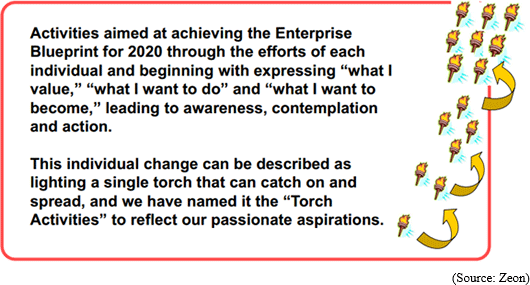 Q: "Then, please give your message to investors and shareholders."
A: "We would like to contribute to the development of a convenient, comfortable society by developing and supplying a lot of unique products. We would appreciate your support from the mid/long-term viewpoint."
As mentioned before, Zeon's value and social raison d'etre are the originality based on its technology developed under the philosophy to avoid imitating others, and do things anyone cannot imitate.
Since our company does not produce end products, our company is not popular among individual investors, but we hope to contribute to the development of a more convenient, comfortable society by actively investing in R&D, pursuing effectiveness, developing and supplying a lot of products that cannot be produced by any other companies. We hope that you will support us from a medium-to-long term perspective. Q: "Then, please give your message to investors and shareholders."
A: "We would like to contribute to the development of a convenient, comfortable society by developing and supplying a lot of unique products. We would appreciate your support from the mid/long-term viewpoint."
As mentioned before, Zeon's value and social raison d'etre are the originality based on its technology developed under the philosophy to avoid imitating others, and do things anyone cannot imitate.
Since our company does not produce end products, our company is not popular among individual investors, but we hope to contribute to the development of a more convenient, comfortable society by actively investing in R&D, pursuing effectiveness, developing and supplying a lot of products that cannot be produced by any other companies. We hope that you will support us from a medium-to-long term perspective.
|
| Conclusions |
|
The previous report mentions, "We would like to pay attention to how much the company will improve its performance in the remaining three months, while the risk of significant decline is unlikely to occur in the external environment, after the second upward revision to the forecast." Sales and profit decreased between the third quarter (Oct. to Dec.) and the fourth quarter (Jan. to Mar.), and became nearly equal to the revised estimates.
This term, sales and profit are forecasted to drop, but we would like to pay attention to how the current exchange rate: 1 dollar = 110 yen will affect the performance, while it was assumed that 1 dollar = 100 yen.
In the medium/long term, we would like to see the progress of development of highly effective products, as described in the interview with President Tanaka.
|
| <Reference 1: Regarding Corporate Governance> |
 ◎ Corporate Governance Report
The company submitted a latest corporate governance report on June, 4, 2018
<Basic policy>
Our company respects the interests of a broad range of stakeholders, including shareholders, and aims to earn revenue and continuously improve our corporate value while adjusting the relations of interests. To do so, we will make continuous efforts to establish a system for realizing efficient, sound business administration through corporate governance.
In addition, we will make decisions and execute business operations swiftly after clarifying the functions and roles of each institution and each in-company organization by developing internal control systems. We will properly monitor and disclose its progress and results and strive to improve the transparency of our business administration.
<Reasons for Non-compliance with the Principles of the Corporate Governance Code (Excerpts)>
At the 93rd annual meeting of shareholders, we started disclosing the convocation notice for each general meeting of shareholders in our website before dispatching it (Supplementary Principle 1-2-2). Therefore, our company follows the principles of the corporate governance code. ◎ Corporate Governance Report
The company submitted a latest corporate governance report on June, 4, 2018
<Basic policy>
Our company respects the interests of a broad range of stakeholders, including shareholders, and aims to earn revenue and continuously improve our corporate value while adjusting the relations of interests. To do so, we will make continuous efforts to establish a system for realizing efficient, sound business administration through corporate governance.
In addition, we will make decisions and execute business operations swiftly after clarifying the functions and roles of each institution and each in-company organization by developing internal control systems. We will properly monitor and disclose its progress and results and strive to improve the transparency of our business administration.
<Reasons for Non-compliance with the Principles of the Corporate Governance Code (Excerpts)>
At the 93rd annual meeting of shareholders, we started disclosing the convocation notice for each general meeting of shareholders in our website before dispatching it (Supplementary Principle 1-2-2). Therefore, our company follows the principles of the corporate governance code.
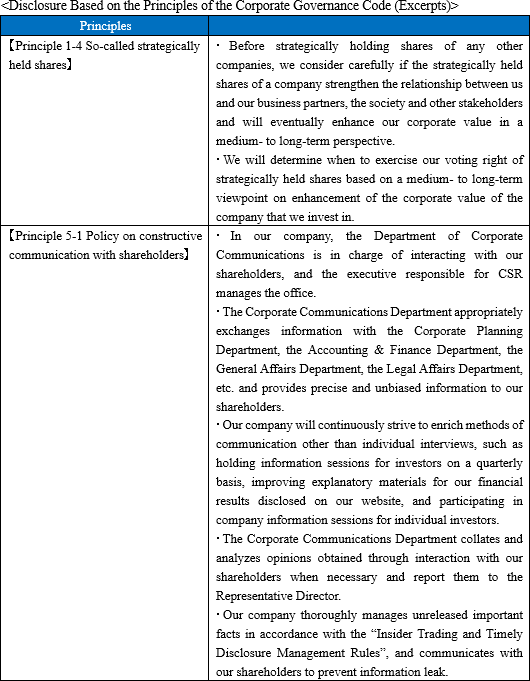 Disclaimer
This report is intended solely for information purposes, and is not intended as a solicitation to invest in the shares of this company. The information and opinions contained within this report are based on data made publicly available by the Company, and come from sources that we judge to be reliable. However, we cannot guarantee the accuracy or completeness of the data. This report is not a guarantee of the accuracy, completeness or validity of said information and or opinions, nor do we bear any responsibility for the same. All rights pertaining to this report belong to Investment Bridge Co., Ltd., which may change the contents thereof at any time without prior notice. All investment decisions are the responsibility of the individual and should be made only after proper consideration.Copyright(C) 2018 Investment Bridge Co., Ltd. All Rights Reserved. |
| <Reference2: Fact Sheet> |
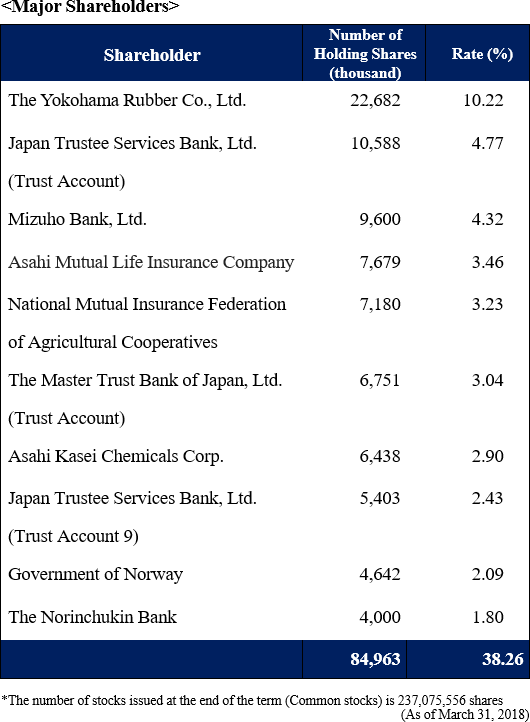 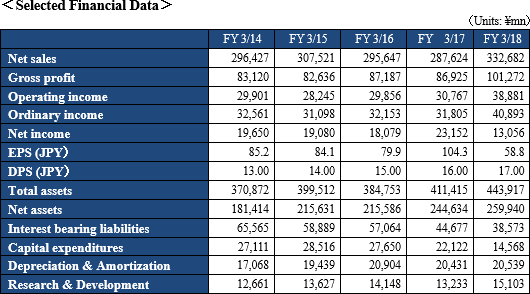 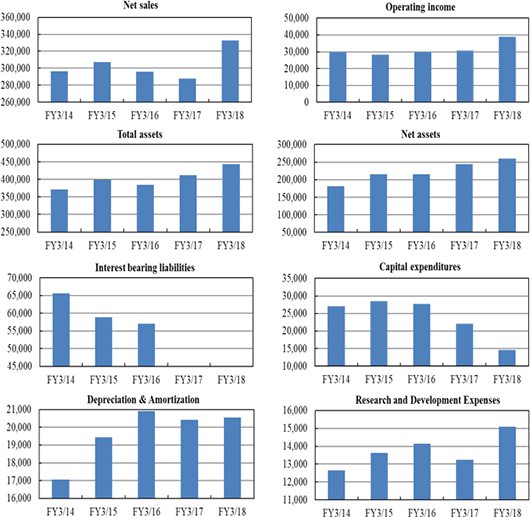 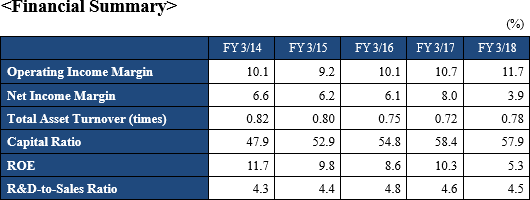 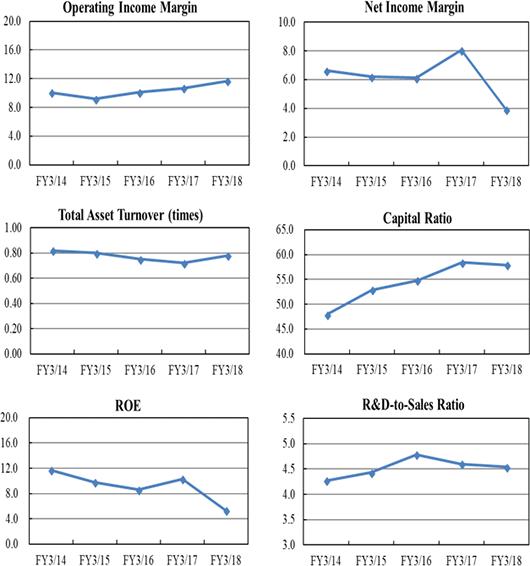 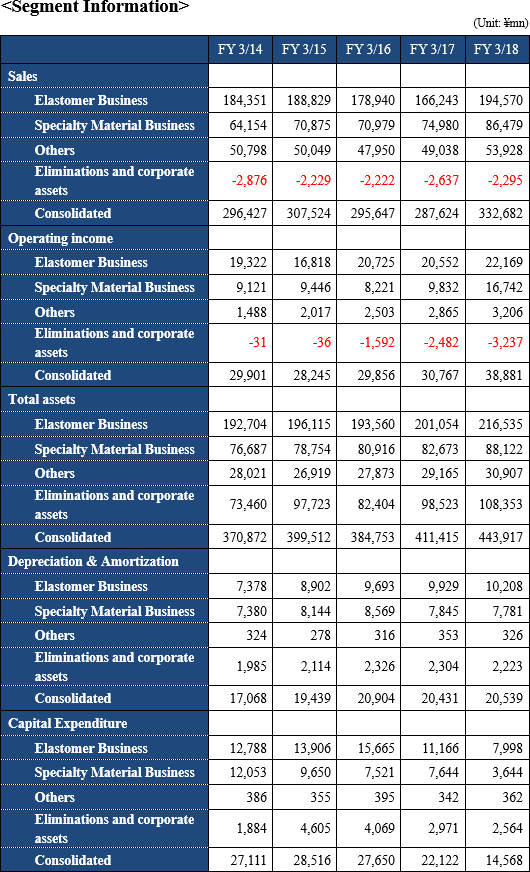  |


